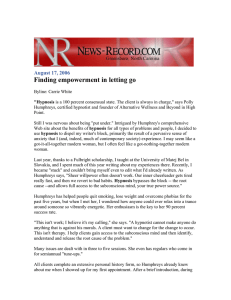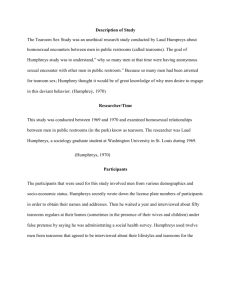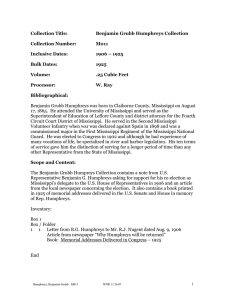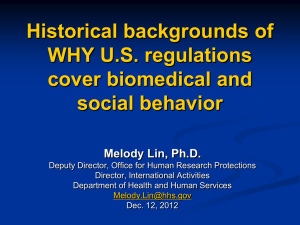Humphreys`s Young Earth Helium Diffusion “Dates”
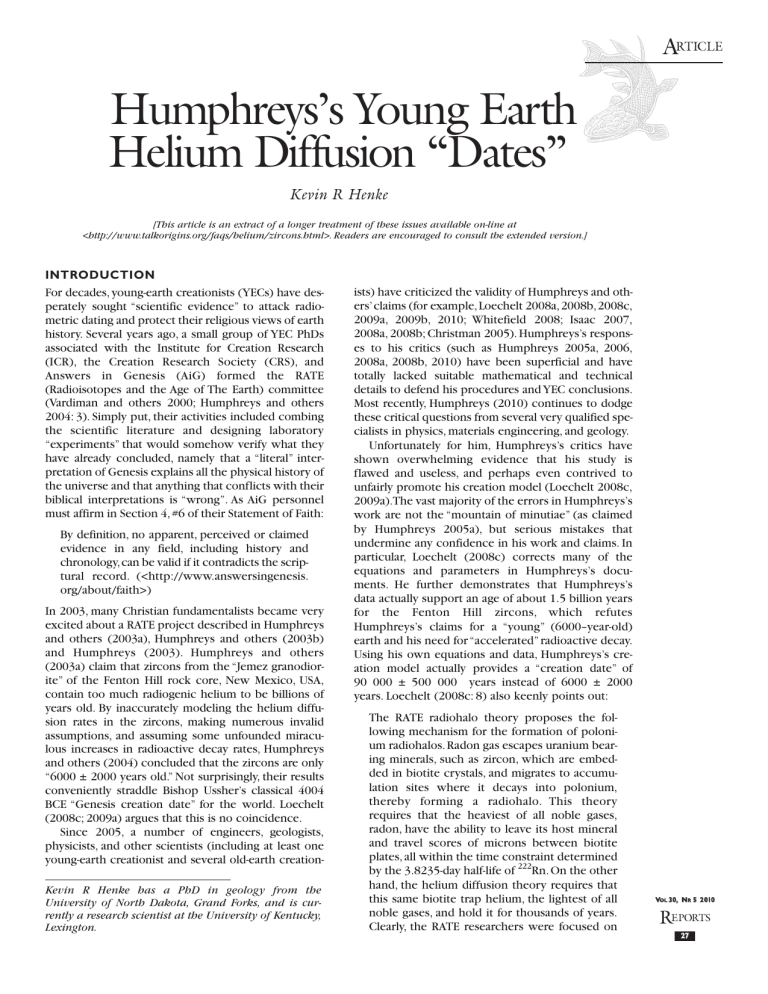
A
RTICLE
Humphreys’s Young Earth
Helium Diffusion “Dates”
Kevin R Henke
[This article is an extract of a longer treatment of these issues available on-line at
<http://www.talkorigins.org/faqs/helium/zircons.html>. Readers are encouraged to consult the extended version.]
INTRODUCTION
For decades, young-earth creationists (YECs) have desperately sought “scientific evidence” to attack radiometric dating and protect their religious views of earth history. Several years ago, a small group of YEC PhDs associated with the Institute for Creation Research
(ICR), the Creation Research Society (CRS), and
Answers in Genesis (AiG) formed the RATE
(Radioisotopes and the Age of The Earth) committee
(Vardiman and others 2000; Humphreys and others
2004: 3). Simply put, their activities included combing the scientific literature and designing laboratory
“experiments” that would somehow verify what they have already concluded, namely that a “literal” interpretation of Genesis explains all the physical history of the universe and that anything that conflicts with their biblical interpretations is “wrong”. As AiG personnel must affirm in Section 4, #6 of their Statement of Faith:
By definition, no apparent, perceived or claimed evidence in any field, including history and chronology,can be valid if it contradicts the scriptural record. (<http://www.answersingenesis.
org/about/faith>)
In 2003, many Christian fundamentalists became very excited about a RATE project described in Humphreys and others (2003a), Humphreys and others (2003b) and Humphreys (2003). Humphreys and others
(2003a) claim that zircons from the “Jemez granodiorite” of the Fenton Hill rock core, New Mexico, USA, contain too much radiogenic helium to be billions of years old. By inaccurately modeling the helium diffusion rates in the zircons, making numerous invalid assumptions, and assuming some unfounded miraculous increases in radioactive decay rates, Humphreys and others (2004) concluded that the zircons are only
“6000 ± 2000 years old.” Not surprisingly, their results conveniently straddle Bishop Ussher’s classical 4004
BCE “Genesis creation date” for the world. Loechelt
(2008c; 2009a) argues that this is no coincidence.
Since 2005, a number of engineers, geologists, physicists, and other scientists (including at least one young-earth creationist and several old-earth creation-
Kevin R Henke has a PhD in geology from the
University of North Dakota, Grand Forks, and is currently a research scientist at the University of Kentucky,
Lexington.
ists) have criticized the validity of Humphreys and others’ claims (for example, Loechelt 2008a, 2008b, 2008c,
2009a, 2009b, 2010; Whitefield 2008; Isaac 2007,
2008a, 2008b; Christman 2005). Humphreys’s responses to his critics (such as Humphreys 2005a, 2006,
2008a, 2008b, 2010) have been superficial and have totally lacked suitable mathematical and technical details to defend his procedures and YEC conclusions.
Most recently, Humphreys (2010) continues to dodge these critical questions from several very qualified specialists in physics, materials engineering, and geology.
Unfortunately for him, Humphreys’s critics have shown overwhelming evidence that his study is flawed and useless, and perhaps even contrived to unfairly promote his creation model (Loechelt 2008c,
2009a).The vast majority of the errors in Humphreys’s work are not the “mountain of minutiae” (as claimed by Humphreys 2005a), but serious mistakes that undermine any confidence in his work and claims. In particular, Loechelt (2008c) corrects many of the equations and parameters in Humphreys’s documents. He further demonstrates that Humphreys’s data actually support an age of about 1.5 billion years for the Fenton Hill zircons, which refutes
Humphreys’s claims for a “young” (6000–year-old) earth and his need for “accelerated” radioactive decay.
Using his own equations and data, Humphreys’s creation model actually provides a “creation date” of
90 000 ± 500 000 years instead of 6000 ± 2000 years. Loechelt (2008c: 8) also keenly points out:
The RATE radiohalo theory proposes the following mechanism for the formation of polonium radiohalos. Radon gas escapes uranium bearing minerals, such as zircon, which are embedded in biotite crystals, and migrates to accumulation sites where it decays into polonium, thereby forming a radiohalo. This theory requires that the heaviest of all noble gases, radon, have the ability to leave its host mineral and travel scores of microns between biotite plates, all within the time constraint determined by the 3.8235-day half-life of
222
Rn. On the other hand, the helium diffusion theory requires that this same biotite trap helium, the lightest of all noble gases, and hold it for thousands of years.
Clearly, the RATE researchers were focused on
V
O
3 0,, N
R
5 2 01
R
EPORTS
S
E
--O
C 2 10
R
EPORTS two isolated phenomena (helium diffusion and radiohalos) rather than solving a more general problem, such as noble gas migration in biotite.
Ironically, the helium diffusion study and the polonium radiohalo study are published as consecutive chapters in the same book [that is,
Vardiman and others 2005].
The vast majority of Humphreys’s critical values that are used in his “dating” equations are either missing, poorly defined, improperly measured or inaccurate. (See my
Internet essay at <http://www.talkorigins.org/faqs/ helium/zircons.html> for more details.)
M
ISIDENTIFICATION OF
F
ENTON
H
ILL
G
NEISSES
Throughout their paper, Humphreys and others
(2003a) claim to have studied biotites and zircons from samples of the “Jemez granodiorite” collected at a depth of 750 meters from the Fenton Hill borehole site. More recently, Humphreys and others (2004: 5) and Humphreys (2005b) continue to refer to their
“granodiorite” samples from depths of 750 and 1490 meters. Granodiorites are igneous rocks that crystallize from melts (magmas) deep in the subsurface. As their name implies, they have intermediate chemical compositions between granites and diorites, which means that granodiorites tend to have more silica than diorites and more magnesium and iron than granites (Hyndman 1985: 46).
A review of the scientific literature on the subsurface geology of the Fenton Hill borehole site indicates that about 75% of the GT-2 and EE-1 cores consist of gneisses (Laughlin 1981: 308; Laney and others 1981:
2) and that granodiorite is not encountered in the cores until depths of 2591 meters (Figure 1) (Laney and others 1981: 1; Laughlin and others 1983; Burruss and Hollister 1979; Sasada 1989: 258). Information in
Laughlin and others (1983) and other references clearly indicate that samples from 750 and 1490 meters are gneisses (Figure 1). Gneisses are former igneous or sedimentary rocks that have been metamorphosed under relatively high temperature and pressure conditions, but without melting (Hyndman
1985: 442; Chernicoff and others 2002: 128).
Even after being presented with evidence from the literature, Humphreys (2005a) still refused to admit that he and his colleagues misidentified gneisses as
“granodiorites”. He continued to insist that most of the Precambrian sections of the Fenton Hill cores are
“granodiorites”. In contrast, Robert Gentry readily admitted in Gentry and others (1982a) that the
Fenton Hill cores consist of a large number of different rock types, including gneisses and other rocks that provided his zircon samples.
The misidentification of the rock types in the
Fenton Hill cores is a serious problem. During their study, Humphreys and others (2003a: 6) agreed that any mixing of samples from different rock types would be inappropriate for their modeling efforts:
Measurements of noble gas diffusion in a given type of naturally occurring mineral often show significant differences from site to site, caused by variations in composition. For that reason it is important to get helium diffusion data on zircon and biotite from the same rock unit (the
Jemez Granodiorite [ sic ]) which was the source of Gentry’s samples. [emphasis added]
Of course, the sizes of zircons and biotites can vary considerably depending on the host rock. Because
Humphreys and colleagues did not correctly identify the rocks they sampled and how the sizes of the minerals could vary, serious errors could easily be introduced into the values used in their age calculations
(equations 13, 14, and 16 in Humphreys and others
2003a). Snelling and Austin are coauthors of
Humphreys and others (2003a; 2004) with PhDs in geology, but non-geologist John Baumgardner was responsible for selecting and identifying the lithologies for this study. In defending this work,
Baumgardner (quoted in Humphreys 2005a) argues:
Yes, there are occasional veins of material other than the coarse-grained granodiorite that forms the vast majority [ sic ] of the core. In making the selections I made of what samples to use, I purposely avoided these occasional veins. In fact I tried to select sections of the core well removed from such veins. So at least from my vantage point, the samples of core we used for the helium diffusion measurements were indeed coarse-grained granodiorite, not gneiss.
Baumgardner's statement that a “coarse-grained granodiorite” forms “the vast majority of the core” completely contradicts statements in Laughlin (1981: 308) and analytical data in Laughlin and others (1983) that approximately 75% of the cores consist of gneisses
(not granodiorite). The dominance of gneisses in the
Precambrian rocks of the Fenton Hill cores is also obvious from Figure 1. Because Baumgardner's conclusions are inconsistent with the results of professional geologists who have examined and analyzed the cores in great detail, I e-mailed him questions about the samples that he had collected for
Humphreys’s papers.
In his gracious reply,
Baumgardner described the core as consisting of dark gneissic “veins” surrounded by an “unaltered granodiorite” consisting of “large (typically, 2–3 mm)” pinkish grains. Although I requested any mineralogical (such as petrographic or X-ray diffraction analyses) or chemical data (that is, major oxides, minor and trace element analyses) that Baumgardner might have to support his claims, he provided none.
By definition (Hyndman 1985: 442), gneisses consist of alternating dark- and light-colored bands and not “veins”. If “dark gneiss veins” [ sic : bands] were present in Humphreys’s samples as Baumgardner claims, where are the light-colored bands of the gneiss? By the definition, how can the Fenton Hill samples have dark gneissic bands and no light-colored gneissic bands associated with them? Baumgardner seems to have misidentified the light-colored gneissic bands as
“unaltered granodiorite”.The light-colored layers of a gneiss often consist of blocky feldspar and quartz grains. Without detailed chemical and microscopic studies, feldspars and quartz in a light-colored gneissic band can readily appear “igneous” and “unaltered” to the unaided eye. Humphreys has yet to produce any
definitive chemical or microscopic evidence to challenge the metamorphic identifications of their samples in Laughlin and others (1983) and other documents. Despite these objections to his characterization of these samples, Humphreys (2008a, 2008b,
2010) continues to refer inaccurately to the relevant metamorphic sections of the Fenton Hill cores as
“granitic rock”.
Faced with disagreement from professional geologists and even Gentry and others (1982a), Humphreys
(2005a) argues that misidentifying a gneiss would not significantly affect their zircon diffusion studies or
“dating” results:
The important point is that, regardless of the name we put on the rock unit [ sic : rock units!
see Figure 1], the zircons throughout it have been measured to contain essentially the same amounts and ratios of lead isotopes (Gentry and others, 1982b), and therefore have undergone the same amount of nuclear decay.The uranium, helium, and lead levels in our samples are perfectly consistent with the corresponding levels
Gentry reported for his. The effect of variation from sample to sample is probably smaller than the 2-sigma error bars around our prediction. So here Henke is making a distinction without a difference.
Several of Humphreys’s assertions are flatly refuted by the chemical data in the very reference that he cites
(Gentry and others 1982b), which shows that uranium and thorium concentrations in the Fenton Hill zircons can vary by more than an order of magnitude even within the same zircon! As Gentry and others
(1982b: 296) admit:
Frequently, there were significant differences in the U and Th concentrations from two different locations on the same zircon.
These differences, of course, reflect the physicochemical process that shaped the history of the rocks in the core sample.
YECs might argue that because Precambrian granodiorites and gneisses were all zapped into existence during the six 24-hour days of the “Creation Week”
(for example, Snelling and Woodmorappe 1998: 530), distinctions between Precambrian rocks really are not important. While these YECs invoke miracles to explain away most Precambrian intrusive rocks,
Humphreys and others (2003a: 2) unintentionally admit that at least some intrusive rocks have significant histories when they claim that zircon crystals become imbedded in larger crystals as a magma “cools and solidifies”. So Humphreys has the impossible task of explaining why the numerous metamorphic and igneous rocks in the Fenton Hill cores (Figure 1) have complex structures and textures that indicate a long history (Laney and others 1981; Laughlin and Eddy
1977; Laughlin and others 1983; Sasada 1989; Loechelt
2008c) rather than a supposed rapid and miraculous formation in only six 24-hour days.
Because Humphreys collected his zircons from gneisses and not granodiorites (Figure 1), he needs to recognize that thermodynamic and other laboratory studies indicate that gneisses and their metamorphic zircons form under much greater metamorphic pressures than could ever have existed at depths of only 750–4310 meters (Hyndman 1985;
Winkler 1979). The gneisses at Fenton Hill were obviously uplifted from much greater depths. By definition, gneisses have gneissic banding, which requires minimum pressures of about 4000–6000 bars and temperatures of about 600–750°C to form. So Humphreys’s gneisses and their zircons were once at depths of at least 15–22 kilometers (Winkler
1979: 5), perhaps for a significant portion of their history. Loechelt (2008c) in his
Appendix A also provides a detailed geologic history of the Fenton Hill cores. Considering that the metamorphic rocks of the Fenton
Hill cores probably spent a lot of their history at depths greater than 15 kilometers,
Humphreys’s modeling of helium diffusion in some zircons from current depths of 750 meters to 4.3 kilometers cannot yield valid information on the beginning of the earth’s geologic history.
Some additional data were likely lost when the rock samples were processed at the
Institute for Creation Research (ICR) laboratory. Humphreys and others (2003a: 17) state that the biotites were extracted through
“crushing, magnetic separation, and density separation with heavy liquids.” However, micas, including biotites, can lose much of their helium through crushing (Trull and
Kurz 1993: 1314; Mussett 1969: 298).
Therefore, grinding the biotite specimens could have resulted in substantial helium loss and significant errors in calculations based on the abundance of helium (Humphreys and others 2003a). Some researchers cut rather than crush micas for argon diffusion studies
(Dalrymple and Lanphere 1969: 147–8).
According to Appendix B of Humphreys and others (2003a), the Fenton Hill biotites were impure, making adequate biotite separation difficult. Certainly, Humphreys (2005a) is correct when he states that different samples provide different degrees of difficulty in mineral separation. However, instead of confronting the problem, Humphreys (2005a) claims that the biotite separations are irrelevant (which invites the question why he should do them at all). In contrast, biotite and its helium diffusion properties have critical roles in some of the models described in Humphreys and others (2003a, especially their figure 7), in deriving data needed for age estimates (equations 12–14 and 17 in Humphreys and others 2003a), and in Humphreys’s invalid “Lyell uniformitarian” claim that current measurements of the diffusion of helium in his Fenton Hill biotites somehow rules out the possibility of extraneous helium contamination in the past .
F
IGURE
1 .
Geology of the Fenton
Hill GT-2 and EE-2 cores based on information in
Laughlin and others (1983:
25–6) and Sasada (1989:
258). The zircons and biotites utilized in
Humphreys and others
(2003a; 2004) are from gneisses and not granodiorites.
V
O
R
3 0,, N
R
5 2 01
EPORTS
M YSTERIOUS M ODIFICATIONS OF G ENTRY ’ S
H
ELIUM
M
EASUREMENTS
There are four important variables in the equations from Humphreys and others (2003a) that they use to date their Fenton Hill samples; these are referred to as
Q , Q0, a , and b .
Q refers to the measured quantity of helium (presumably only radiogenic
4
He) in a mineral; a is a measure of the effective radius of the zircon; and b is the estimated effective radius of the biotite surrounding the zircon. (For the fictitious “Jemez
Granodiorite”, Humphreys and others [2003a] only supply one value each for a and b without providing any standard deviations.) Once a mineral cools below its helium closure temperature and remains below that temperature, Q0 is the maximum amount of
4
He that is expected to accumulate in the mineral from the radioactive decay of its uranium and thorium. A certain percentage of alpha particles (
4
He nuclei) will escape from the host mineral during radioactive decay and this loss is considered when calculating the
Q0 values. Loechelt (2008c) and his references discuss how alpha particle loss may be estimated.
T ABLE 1: Information on the Fenton
Hill, New Mexico, GT-2 and EE-2 well cores, including the original helium concentrations (Q in nano cubic centimeters of heli-
Even if the “dating” equations in Humphreys and others
(2003a) were reliable, they still would need accurate and preum per microgram of zircon at standard temperature and pressure [STP], ncc STP/µg) from Gentry and others (1982a: 1130).
Samples 0 – 6 are from Gentry and others
(1982a). Humphreys and others (2004) is cise measurements of these variables before any of the equations would work.
However, the data in the source of samples 2002 and 2003.
Revised helium (Q) values are from
Humphreys and others (2003a: 3 [post-con-
Humphreys and others (2003a;
2004) are often poorly defined and inaccurate.
For example, Humphreys ference website version]) and Humphreys and others (2004: 3, table I). Depths are from
Humphreys and others (2004: 3, table I).
Gentry and others (1982a) identified the surface lithology as the Bandelier Tuff. The
(2000) simply listed the helium measurements from
Gentry and others (1982a), but after presenting other lithologies are from Laughlin and others (1983).The ratios of measured helium to theoretical radiogenic helium (Q/Q
0 values) are from Humphreys and others (2003a,
Humphreys and others
(2003a) at a creationist conference, Humphreys, in consultation with Gentry, concluded
2003b, 2004) and Gentry and others
(1982a). Humphreys (2005b: 30) indicates that the ± 30% for the Q/Q0 values are “very conservatively” one-sigma random errors.
that the helium measurements
(Gentry and others 1982a) had “typographic errors”.Their
undocumented “corrections” to these measurements included lowering most of the
Q values by 10 times (Table 1).As others (for example,
Isaac 2008b) and I have noted, Humphreys has yet to reveal details on how these “typographic errors” were discovered and reliably corrected, while at the same time, the associated Q/Q0 values could remain unaffected. Humphreys (2005a) wrote: “Gentry’s original calculations are no longer available.” But, if they did not have Gentry’s original calculations or laboratory notes, how do they know after more than 20 years that typographic errors had been made in Gentry and others (1982a)?
Using a series of questionable and vague assumptions, Gentry and others (1982a) derived a single maximum helium retention ( Q0 ) value for their samples
1–6 and used it to calculate the amount of retained helium ( Q/Q0 values) for the six samples. Humphreys and others (2003a; 2004) took the high Q / Q0 values from Gentry and others (1982a) and “corrected” the
“typographic errors” in the helium measurements ( Q ), which yield a Q0 of about 15 nano cubic centimeters
(ncc) at standard temperature and pressure per microgram of zircon (ncc STP/µg). Using the available information from Gentry and others (1982a) and ignoring the possibility of extraneous
4
He and
3
He, I was unable to derive a Q0 of 15 ncc STP/µg for the zircons.
Instead, I found that the assumptions in Gentry and others (1982a) yield a Q0 of 41 ncc STP/µg. Loechelt
(2008c: 5) also concluded that the assumptions in
Gentry and others (1982a) would yield a Q0 of about
40 ncc STP/µg (detailed calculations are available on-line at <http://www.talkorigins.org/faqs/helium/ zircons.html> in appendices A and B).
Meanwhile, Humphreys (2005a) still does not adequately explain how he and Gentry and others
(1982a) calculated a Q0 of only 15 ncc STP/µg (also see appendix A in <http://www.talkorigins.org/faqs/ helium/zircons.html>) and why chemical data in
Gentry and others (1982b) indicate that Q0 is typically much greater (perhaps as high as 800 ncc STP/µg; see table B8 in appendix B at <http://www.talkorigins.
org/faqs/helium/zircons.html>).
The problems with Humphreys’s conclusion go far beyond whether the calculations are accurate. Even if
Gentry and others (1982a) and I had obtained the same Q0 value, I would still argue that their approach
Table 1: Original and “Corrected” Data from Gentry and others (1982a).
Sample Depth Well Core
Number (meters) Number
4
5
2
3
6
0
2002
1
2003
0
750
960
1490
2170
2900
3502
3930
4310
GT-2
GT-2
GT-2
GT-2
GT-2
EE-2
EE-2
EE-2
Actual Lithologies He measurements ( Q ) New or Revised He from Gentry and others (1982a) (ncc STP/µg) from Gentry measurements in and Laughlin and others (1983) and others (1982a)
Q/Q0
Humphreys and others (±30%, 1 s )
Gneiss
Gneiss
Gneiss
Gneiss
Granodiorite; Monzogranite
Gneiss; Monzogranite
Granodiorite
Gneiss; Granodiorite
82
---
86
---
36
28
0.76
~0.2
~0.2
(2004) ( Q ) (ncc STP/µg)
8.2
~12.1
8.6
6.3
3.6
2.8
0.16
~0.02
~0.02
---
~0.80
0.58
0.42
0.27
0.17
0.012
~0.001
~0.001
and assumptions were flawed from the very beginning and that their Q0 and Q/Q0 values should be discarded because their samples 1–6 came from a variety of rock types, which means that the uranium concentrations in the zircons from these various igneous and metamorphic rocks ought to be very different, and so would the Q0 and Q/Q0 values at the different depths within the Fenton Hill rock cores. Indeed, Gentry and others (1982b) even show that the uranium and thorium concentrations of the Fenton Hill zircons are highly variable within single zircons (table B1 in appendix B at <http://www.talkorigins.org/faqs/ helium/zircons.html>).
There are other problems with estimates from
Humphreys’s models.The equations estimating the age of the samples require accurate and well-defined values of a (radius of the zircons), which are currently unavailable. In their models Humphreys and others (2003a: 8) assume that helium diffusion in zircons is isotropic
(that is, spherical) and could be represented by a single effective radius, a . In reality, zircons have tetragonal
(anisotropic) crystalline structures, which affect the flow of helium through the minerals. Nevertheless,
Loechelt (2008c: 6) cites Meesters and Dunai (2002):
A rigorous diffusion model would use a realistic
3-dimensional geometry. It has been demonstrated through direct computation, however, that a simpler spherical geometry is a reasonably good approximation provided the effective radius [ a ] is chosen such that the surface-to-volume ratio of the sphere is the same as the geometry ... [Loechelt’s emphasis]
Humphreys and others (2004: 15) address the issue of zircon anisotropy by claiming that switching the diffusion geometry of their zircons from an isotropic sphere to an anisotropic cylinder would change their results by less than a factor of two.This claim might be true, but Humphreys and others (2004) provide no calculations to support this claim. Furthermore, Humphreys
(2005a) admits that the sizes of the zircons in his 750meter (2002) sample were never determined. Instead, he simply assumed that a was 30 microns. Gentry and others (1982a) also does not contain adequate information on the lengths and widths of their zircons.
Equations 12–14 and 17 in Humphreys and others
(2003a) require that b (the effective radius of biotite surrounding each zircon) must be known in order to obtain “helium diffusion dates” with these equations.
Because of the well-developed and prominent cleavage planes between biotite layers, biotite is very anisotropic. Helium would tend to migrate through the planes rather than perpendicular or oblique to them.Clearly,an isotropic effective radius of b is inappropriate for this mineral. Yet, Humphreys and others (2003a) assumed that biotite is isotropic in their models (figure 7 in
Humphreys and others 2003a). Even if the use of b was appropriate, Humphreys and others (2003a: 8) only list one b value — an “average” of ~1000 microns, which is from their 750-meter (2002) sample. Humphreys and others (2003a) also do not indicate how many grains were measured to obtain this average, they provide no standard deviations for this value, and they apply this one value (as he did with their Q0 value) to other samples from the Fenton Hill cores. Because descriptions in
Laughlin and others (1983) indicate that samples 1–6 in
Gentry and others (1982a) and samples 2002 and 2003 from Humphreys and others (2004) were from diverse metamorphic and igneous rocks (Table 1), it is likely that the sizes, and therefore the b values, of the biotites from these different rocks are very dissimilar.
If we overlook the problems with the data themselves, and use the “dating” equations from
Humphreys and others (2003a), the currently best available a , b , and Q/Q0 values yield an average age of
90 000 ± 500 000 years (2 unbiased standard deviations) for the Fenton Hill zircons (see table 4 at
<http://www.talkorigins.org/faqs/helium/zircons.
html>). Now, Humphreys and other YECs might view the average “date” of 90 000 years to be recent enough to support young-earth creationism and refute “uniformitarianism”. However, the estimated dates that result from applying Humphreys’s equations to the best available data scatter so widely that just one unbiased standard deviation easily exceeds the overall average date of 90 000 years.
This brief summary examines only a few of the many difficulties with the dating models that
Humphreys used to generate his estimate of the age of the earth. More problems are discussed at length in the original article posted at <http://www.talkorigins.org/ faqs/helium/zircons.html>, including evidence of manipulating data from Magomedov (1971) and the highly dubious “peer-review” system within the
Creation Research Society Quarterly . Many YECs consider RATE to be the finest example of young-earth creationist research, but, in the end, the shortcomings of the research (missing or inaccurate data, imprecise or inconsistent application of models and computations, overlooking or minimizing confounding variables or contradictory data) say otherwise. If these shortcomings were corrected, the models would show a much older origin for the rocks in this sample than a young-earth creationist model could accept (see
Loechelt 2008c).Yet YEC models and oaths of biblical allegiance cannot allow for these corrections.The critical issues in Humphreys’s approach lie deeper than the known inaccuracies reported by Humphreys
(Humphreys and others 2003a) or Gentry (Gentry and others 1982a), but whether Humphreys and his YEC colleagues will refine their conclusions based on improvements in data collection and mathematical models, or instead continue to adjust their models and data to fit their predetermined conclusions.
A
CKNOWLEDGMENTS
Internet comments on Humphreys and others (2003a, 2003b) and
Humphreys (2003) by “WeHappyFew”, Joseph G Meert, and Jack
DeBaun were exceptionally insightful. John Baumgardner kindly provided helpful information on Humphreys’s samples.A number of scientists and other individuals peer-reviewed and provided valuable comments on various versions of this essay, including:
Tom Baillieul, Tom Bridgman, John Brawley, Paul Heinrich, Mike
Hopkins, Mark Isaak, Mark D Kluge, Ted Lawry, Frank Lovell and several anonymous scientists and other individuals.
R
EFERENCES
Burruss RC, Hollister LS. 1979. Evidence from fluid inclusions for a paleogeothermal gradient at the geothermal test well sites, Los Alamos, New
Mexico.
Journal of Volcanology and Geothermal Research 5: 163–77.
V
O
3 0,, N
R
5 2 01
R
EPORTS
S
E
--O
C 2 10
R
EPORTS
Chernicoff S, Fox HA,Tanner LH. 2002.
Earth: Geologic Principles and
History . Boston: Houghton Mifflin Company.
Christman TK. 2005. Creation science rebuttals: Institute for Creation
Research critique of RATE group’s zircon-helium diffusion project
[Internet]. Available from: <http://www.answersincreation.org/
RATE_critique_he-zr.htm>. Last accessed September 22, 2010.
Dalrymple GB, Lanphere MA. 1969 . Potassium-Argon Dating:
Principles, Techniques and Applications to Geochronology . San
Francisco:WH Freeman and Co.
Gentry RV,Gush GL,McBay ER.1982a.Differential helium retention in zircons: implications for nuclear waste containment.
Geophysical Researh
Letters 9 (10): 1129–30. Available from: <http://www.halos.com/ reports/grl-1982-helium-in-zircons.pdf>. Last accessed September 22,
2010.
Gentry RV, Sworski TJ, McKown HS, Smith DH, Eby RE, Christie WH.
1982b. Differential lead retention in zircons: Implications for nuclear waste containment.
Science 216: 296–8.
Available from:
<http://www.halos.com/reports/science-1982-lead-in-zircons.pdf>.
Last accessed September 22, 2010.
Humphreys DR. 2000.Accelerated nuclear decay:A viable hypothesis?
In:Vardiman L, Snelling AA, Chaffin EF, editors.
Radioisotopes and the
Age of the Earth . El Cajon (CA): Institute for Creation Research. p
333–79. Available from: <http://www.icr.org/i/pdf/research/rateall.pdf>. Last accessed October 13, 2010.
Humphreys DR. 2003. New RATE data support young world.
Impact
366. Available from: <http://www.icr.org/pdf/imp/imp-366.pdf>. Last accessed November 2, 2010.
Humphreys DR. 2005a, Helium evidence for a young world remains crystal clear [Internet]. Available from: <http://www.trueorigin.
org/helium01.asp>. Last accessed October 10, 2010.
Humphreys DR. 2005b. Young helium diffusion age of zircons supports accelerated nuclear decay. In Vardiman L, Snelling AA, Chaffin EF, editors.
Radioisotopes and the Age of the Earth: Results of a Young-
Earth Creationist Research Initiative . El Cajon (CA): Institute for
Creation Research. p 25–100.
Humphreys DR. 2006. Helium evidence for a young world overcomes pressure [Internet]. Available from: <http://www.trueorigin.org/ helium02.asp>. Last accessed October 10, 2010.
Humphreys DR. 2008a. What ASA does not want its readers to know.
Creation Matters 13 (2): 1,4. Available from: <http://www.creation
research.org/creation_matters/pdf/2008/CM13%2002%20low%20res.
pdf>. Last accessed September 22, 2010.
Humphreys DR. 2008b. Helium evidence for a young world continues to confound critics [Internet]. Available from: <http://creation.com/ helium-evidence-for-a-young-world-continues-to-confound-critics>.
Last accessed September 19, 2010.
Humphreys DR. 2010. Critics of helium evidence for a young world now seem silent.
Journal of Creation 24 (1): 14–6.
Humphreys DR,Austin SA, Baumgardner JR, Snelling AA. 2003a. Helium diffusion rates support accelerated nuclear decay. In: Ivey R, editor.
Proceedings of the Fifth International Conference on Creationism ,
R. Pittsburgh (PA): Creation Science Fellowship. Available from:
<http://www.icr.org/pdf/research/Helium_ICC_7-22-03.pdf>. Last accessed September 22, 2010.
Humphreys DR, Austin SA, Baumgardner JR, Snelling AA. 2003b.
Precambrian zircons yield a helium diffusion age of 6000 years.
[Abstract]. Published as: Recently measured helium diffusion rate for zircon suggests inconsistency with U-Pb Age for Fenton Hill granodiorite, in Eos, Transactions of the American Geophysical Union 84
(46).
Available from: <http://www.icr.org/pdf/research/
AGUHeliumPoster_Humphreys.pdf>. Last accessed September 22,
2010.
Humphreys DR,Austin SA, Baumgardner JR, Snelling AA. 2004. Helium diffusion age of 6000 years supports accelerated nuclear decay.
Creation Research Society Quarterly 41 (1): 1–16. Available from:
<http://www.creationresearch.org/crsq/articles/41/41_1/Helium_lo_ res.pdf>. Last accessed September 21, 2010.
Hyndman DW. 1985.
Petrology of Igneous and Metamorphic Rocks.
New York: McGraw-Hill.
Isaac R. 2007. Assessing the RATE Project [Internet]. Available from:
<http://www.asa3.org/ASA/education/origins/rate-ri.htm#helium>. Last accessed September 21,2010.
Isaac R. 2008a. A dialogue about RATE: Isaac replies [Internet].
Available from: <http://www.asa3.org/ASA/education/origins/ratepscf.htm#helium>. Last accessed September 21, 2010.
Isaac R. 2008b. Helium diffusion and retention in zircons [Internet].
Available from: <http://www.asa3.org/ASA/education/origins/ helium-ri.htm>. Last accessed September 21, 2010.
Laney R,Laughlin AW, Aldrich MJ Jr. 1981.
Geology and Geochemistry of Samples. Los Alamos National Laboratory HDR Well EE-2, Fenton
Hill, New Mexico . LA-8923-MS. Los Alamos (NM): National Technical
Information Service.
Laughlin AW. 1981. The geothermal system of the Jemez Mountains,
New Mexico and its exploration. In: Rybach L, Muffler LJP, editors.
Geothermal Systems: Principles and Case Histories New York: John
Wiley & Sons. p 295–320.
Laughlin W, Eddy AC. 1977. Petrolography and geochemistry of
Precambrian rocks from GT-2 and EE-1.
Los Alamos Scientific
Laboratory. Report LA-6930-MS . Los Alamos (NM): Los Alamos
Scientific Laboratory.
Laughlin AW, Eddy AC, Laney R, Aldrich MJ Jr. 1983. Geology of the
Fenton Hill, New Mexico, hot dry rock site.
Journal of Volcanology and Geothermal Research 15: 21–41.
Loechelt GH. 2008a. Helium diffusion in zircon: Flaws in a young-earth argument, Part 1 [Internet]. Available from: <http://www.
reasons.org/tnrtb/2008/09/10/>. Last accessed September 21, 2010.
Loechelt GH. 2008b. Helium diffusion in zircon: Evidence supports an old earth, Part 2 [Internet]. Available from <http://www.
reasons.org/tnrtb/2008/09/17/>. Last accessed September 21, 2010.
Loechelt GH. 2008c. Fenton Hill revisited: The retention of helium in zircons and the case for accelerated nuclear decay [Internet].Available
from <http://www.reasons.org/files/HeliumDiffusionZircon
TechnicalpPaper.pdf >. Last accessed September 20, 2010.
Loechelt GH. 2009a. A response to the RATE team regarding helium diffusion in zircon [Internet]. Available from: <http://www.asa3.
org/ASA/education/origins/helium-gl4.htm>. Last accessed September
18, 2010.
Loechelt GH. 2009b. Helium diffusion in zircon: A response to questions by the RATE team [Internet]. Available from: <http://www.
reasons.org/HeliumDiffusioninZirconAResponsetoQuestionsbythe
RATETeam>. Last accessed September 21, 2010.
Loechelt GH. 2010. Expanding on helium in zircons [Internet].
Available from: <http://www.asa3.org/ASA/education/origins/heliumgl.htm>. Last accessed September 19, 2010.
Magomedov ShA. 1970. [Migration of radiogenic products in zircon].
Geokhimiya 2: 263–7.
Geochemistry International 7 (1): 203.
[Russian with English abstract].
Meesters AGCA, Dunai TJ. 2002. Solving the production-diffusion equation for finite diffusion domains of various shapes Part I. Implications for low-temperature (U-He)/He thermochronology.
Chemical Geology
186: 333–44.
Mussett AE. 1969. Diffusion measurements and the potassium-argon method of dating.
Geophysical Journal of the Royal Astronomical
Society 18: 257–303.
Sasada M. 1989. Fluid inclusion evidence for recent temperature increases at Fenton Hill hot dry rock test site west of the Valles
Caldera, New Mexico, USA.
Journal of Volcanology and Geothermal
Research 36: 257–66.
Snelling AA, Woodmorappe J. 1998.The cooling of thick igneous bodies on a young earth. In: Walsh RE, ed.
Proceedings of the Fourth
International Conference on Creationism . Pittsburgh (PA): Creation
Science Fellowship. Available from: <http://static.icr.org/i/pdf/ technical/The-Cooling-of-Thick-Igneous-Bodies-on-a-Young-
Earth.pdf>. Last accessed October 19, 2010.
Trull TW, Kurz MD. 1993. Experimental measurements of 3He and 4He mobility in olivine and clinopyroxene at magmatic temperatures.
Geochimica et Cosmochimica Acta 57: 1313–24.
Vardiman L, Snelling AA, Chaffin EF, eds. 2000.
Radioisotopes and the
Age of the Earth . El Cajon (CA): Institute for Creation Research.
Available from: <http://www.icr.org/pdf/research/rate-all.pdf>. Last accessed September 23, 2010.
Vardiman L, Snelling AA, Chaffin EF, eds. 2005.
Radioisotopes and the
Age of the Earth: Results of a Young-Earth Creationist Research
Initiative . El Cajon (CA): Institute for Creation Research.
Whitefield R. 2008. The RATE Project Claims 22 000 º K? Really?
[Internet]. Available from: <http://www.asa3.org/ASA/education/ origins/helium-rw.pdf>. Last accessed September 10, 2010.
Winkler HGF. 1979.
Petrogenesis of Metamorphic Rocks , 5th ed. New
York: Springer-Verlag.
A
UTHOR
’
S ADDRESS
Kevin R Henke c/o NCSE
PO Box 9477
Berkeley CA 94709-0477 info@ncse.com



